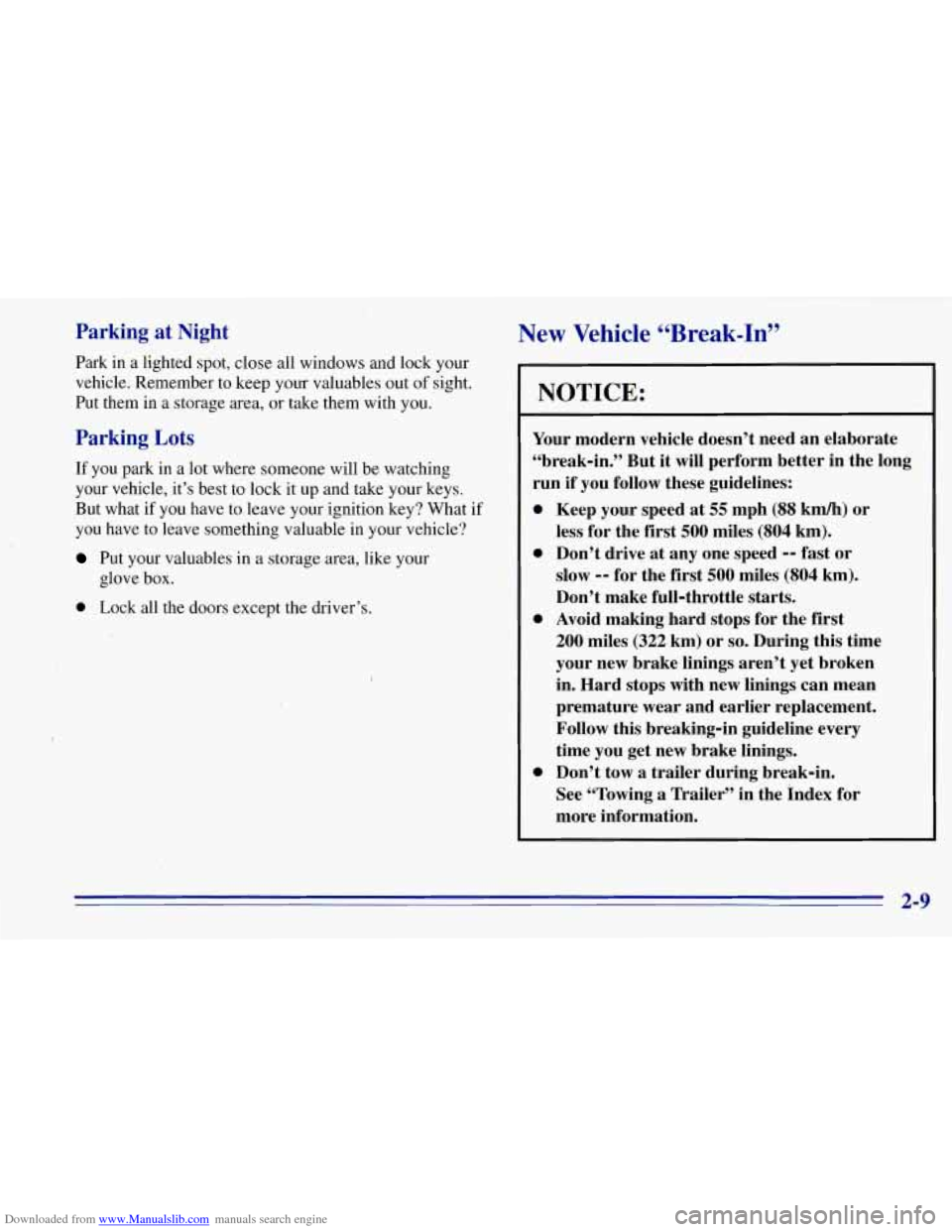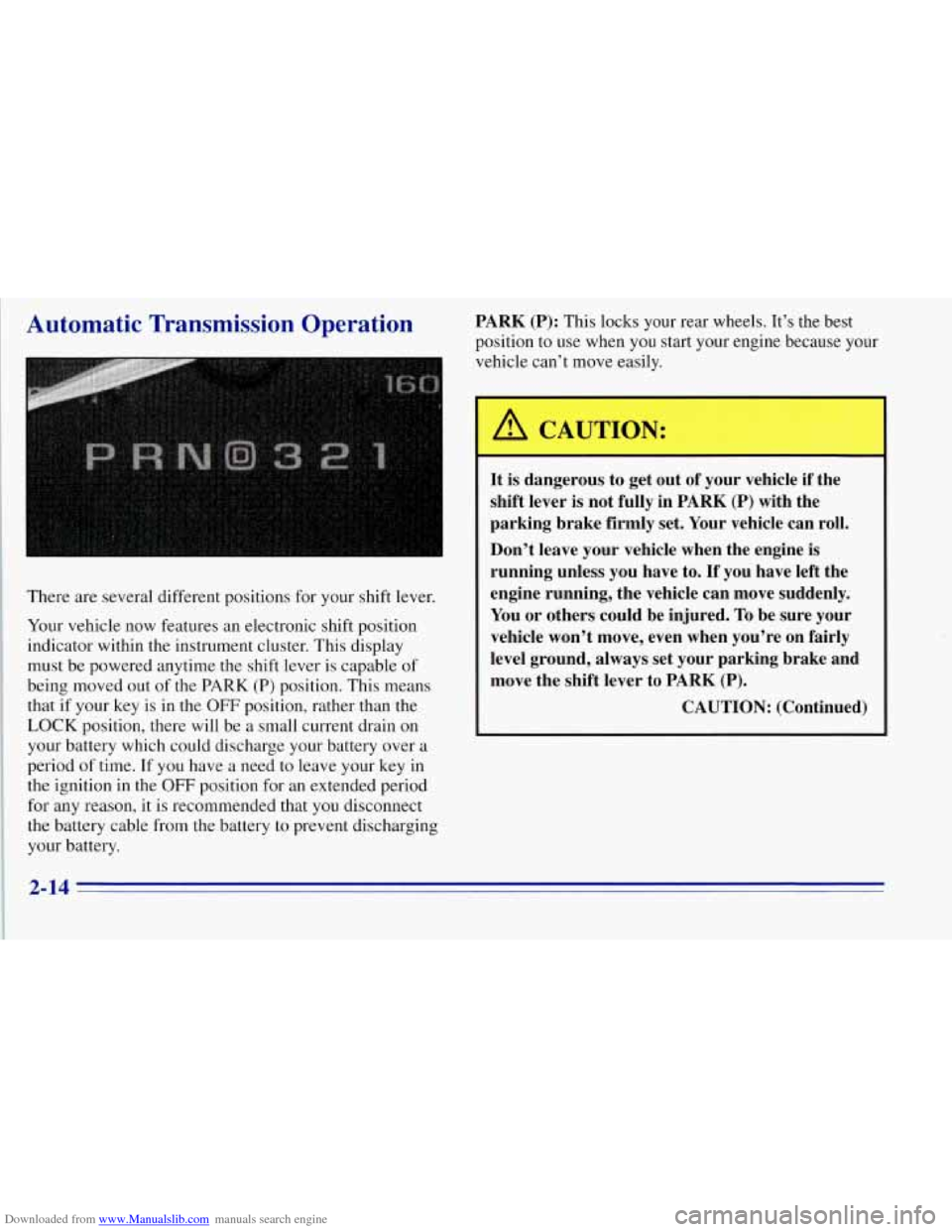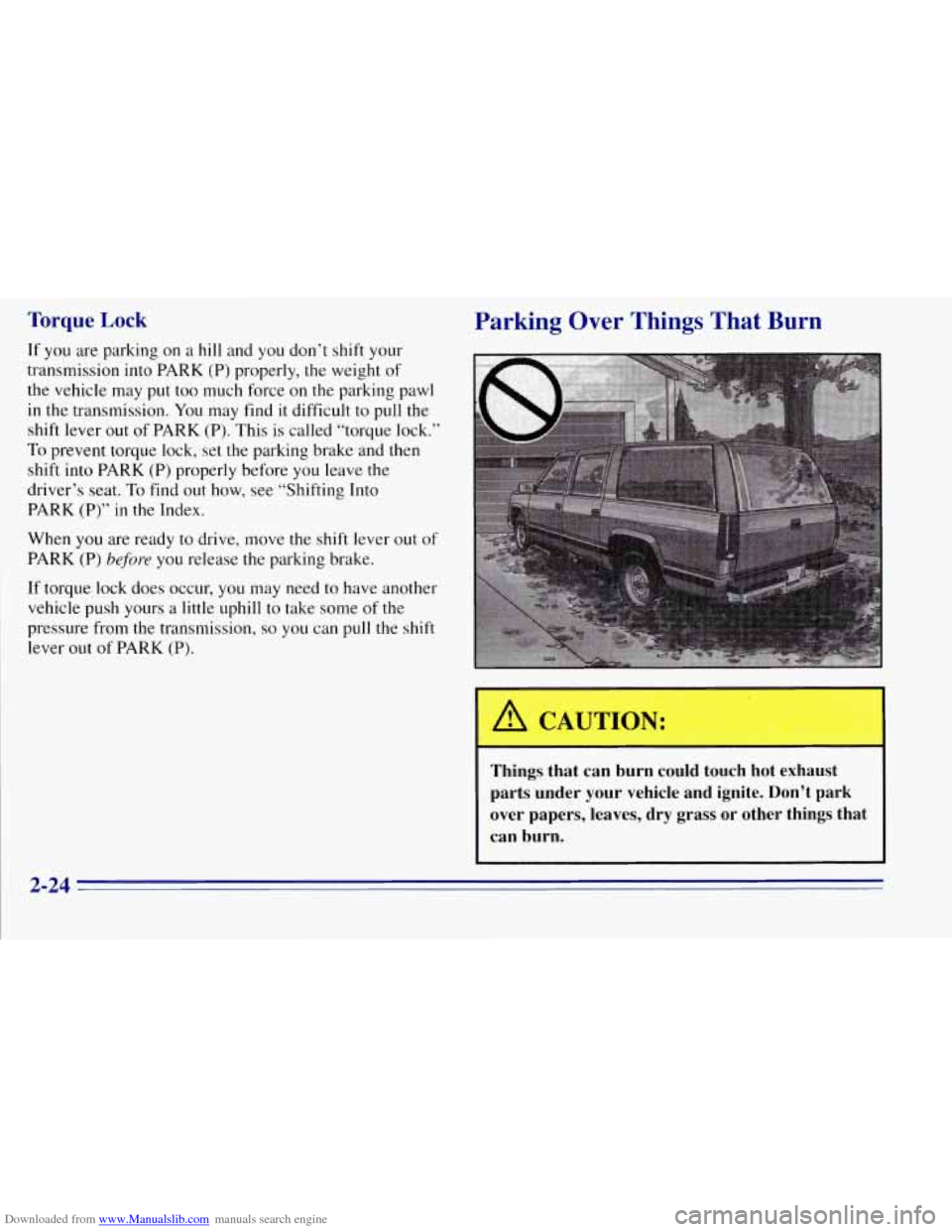Page 72 of 403

Downloaded from www.Manualslib.com manuals search engine Parking at Night
Park in a lighted spot, close all windows and lock your
vehicle. Remember to keep
your valuables out of sight.
Put them in a storage area,
or take them with you.
Parking Lots
If you park in a lot where someone will be watching
your vehicle, it’s best
to lock it up and take your keys.
But what
if you have to leave your ignition key? What if
you have to leave something valuable in your vehicle?
Put your valuables in a storage area, like your
0 Lock all the doors except the driver’s.
glove box.
New Vehicle “Break-In”
NOTICE:
Your
modern vehicle doesn’t need an elaborate
“break-in.” But it wil1,perform better in the long
run
if you follow these guidelines:
0
0
0
0
Keep your speed at 55 mph (88 kmh) or
less for the first
500 miles (804 km).
Don’t drive at any one speed 0- fast or
slow
-- for the first 500 miles (804 km).
Don’t make full-throttle starts.
Avoid making hard stops for the
first
200 miles (322-km) or so. During this time
your new brake linings aren’t yet broken
in. Hard stops with new linings can mean
premature wear and earlier replacement.
Follow this breaking-in guideline every
time you get new brake linings.
Don’t tow a trailer during break-in.
See “Towing a Trailer” in the Index for
more information.
2-9
Page 77 of 403

Downloaded from www.Manualslib.com manuals search engine Automatic Transmission Operation
There are several different positions for your shift lever.
Your vehicle now features an electronic shift position
indicator within the instrument cluster. This display
must be powered anytime the shift lever is capable of
being moved out
of the PARK (P) position. This means
that if your key is in the
OFF position, rather than the
LOCK position, there will be a small current drain on
your battery which could discharge your battery over a
period
of time. If you have a need to leave your key in
the ignition in the
OFF position for an extended period
for any reason, it
is recommended that you disconnect
the battery cable from the battery to prevent discharging
your battery.
PARK (P): This locks your rear wheels. It’s the best
position to use when you start your engine because your
vehicle can’t move easily.
A CAUTION:
It is dangerous to get out of your vehicle if the
shift lever is not fully in PARK (P) with the
parking brake firmly set. Your vehicle can roll.
Don’t leave your vehicle when the engine is
running unless you have to.
If you have left the
engine running, the vehicle can move suddenly.
You or others could be injured. To be sure your
vehicle won’t move, even when you’re
on fairly
level ground, always set your parking brake and
move the shift lever to PARK (P).
CAUTION: (Continued)
2-14
Page 84 of 403

Downloaded from www.Manualslib.com manuals search engine Shifting from 4LO to 4HI or 2HI
To shift from 4LO to 4HI or 2HI your vehicle must be
stopped or moving less than
3 mph (4.8 kdh) with the
transmission
in NEUTRAL (N). The preferred method
for shifting out of 4LO is to have your vehicle moving
1 to 2 mph (1.6 to 3.2 kdh). Press and release the 4HI
switch.
You must wait for the 4HI indicator light to stop
flashing and remain illuminated before shifting your
transmission into gear.
If the 4HI switch is pressed when your vehicle is in
gear and/or moving, the 4HI indicator light
will flash
for
30 seconds but not complete the shift unless the
vehicle is moving slower than
3 mph (4.8 kdh) and
the transmission is
in NEUTRAL (N).
Parking Brake
To set the parking brake, hold the regular brake pedal
down
with your right foot. Push down the parking brake
pedal with your left foot.
If the ignition
is on, the brake system warning light will
come on.
To release the parking
brake, hold the regular
brake pedal down. Pull
the lever, located just
above the parking brake
pedal, marked
BRAKE
RELEASE, to release the
parking brake.
If the ignition is on when the parking brake is released,
the brake system warning light will
go off.
NOTICE:
Driving with the parking brake on can cause
your rear brakes to overheat. You may have to
replace them, and you could also damage other
parts
of your vehicle.
If you are towing a trailer and are parking on any hill,
see “Towing a Trailer” in the Index. That section
shows
what to do first to keep the trailer from moving.
2-21
Page 85 of 403
Downloaded from www.Manualslib.com manuals search engine Shifting Into PARK (P)
A CAUTION:
It can be dangerous to get out of your vehicle if
the shift lever is not fully in PARK
(P) with the
parking brake firmly set. Your vehicle can roll.
If you have left the engine running, the vehicle
can move suddenly. You or others could be
injured.
To be sure your vehicle won’t move,
even when you’re on fairly level ground, use
the steps that follow.
If you have four-wheel
drive and your transfer case is in NEUTRAL (N),
your vehicle will be free to roll, even if your shift
lever is in PARK (P).
So, be sure the transfer case
is in
a drive gear -- not in NEUTRAL (N). If
you’re pulling a trailer, see “Towing
a Trailer” in
the Index.
Steering Column Shift Lever
1. Hold the brake pedal down with your right foot
2. Move the shift lever into PARK (P) position
and set the
parking brake.
like this:
0 Pull the lever toward you.
2-22
Page 86 of 403

Downloaded from www.Manualslib.com manuals search engine 0 Move the lever up as far as it will go.
3. If you have four-wheel drive, be sure the transfer
case is in a drive gear
-- not in NEUTRAL (N).
4. Move the ignition key to LOCK.
5. Remove the key and take it with you. If you can
leave your vehicle with the ignition key
in your
hand, your vehicle is in PARK (P).
Leaving Your Vehicle With the
Engine Running
A LAUTION:
It can be dangerous to leave your vehicle with the
engine running.
Your vehicle could move suddenly
if the shift lever is not fully in PARK
(P) with the
parking brake
firmly set. If you have four-wheel
drive with
a manual transfer case shift lever and
your transfer case is in
NEUTRAL (N), your
vehicle will be free to roll, even
if your shift lever
is in PARK (P).
So be sure the transfer case is in a
drive gear -- not in NEUTRAL (N). And, if you
leave the vehicle with the engine running, it could
overheat and even catch fire.
You or others could
be injured. Don’t leave your vehicle with the
engine running unless you have to.
2-23
Page 87 of 403

Downloaded from www.Manualslib.com manuals search engine Torque Lock
If you are parking on a hill and you don’t shift your
transmission into PARK (P) properly, the weight
of
the vehicle may put too much force on the parking pawl
in the transmission. You may find it difficult to pull the
shift lever out
of PARK (P). This is called “torque lock.”
To prevent torque lock, set the parking brakeland then
shift into PARK
(P) properly before you leave the
driver’s seat.
To find out how, see “Shifting Into
PARK (P)” in
the Index.
When
you are ready to drive, move the shift lever out of
PARK (P) before you release the parking brake.
If torque,
lock does occur, you may need to have another
vehicle push yours a little uphill to take some of the
pressure from the transmission,
so you can pull the shift
lever
out of PARK (P).
Parking Over Things That Burn
Things that can burn could touch hot exhaust
parts under your vehicle and ignite. Don’t park
over papers, leaves, dry grass or other things that
can burn.
I I
2-24
Page 89 of 403
Downloaded from www.Manualslib.com manuals search engine A CAUTION:
A
It can be dangerous to get out of your vehicle if
the shift lever is not fully in
PARK (P) with the
parking brake firmly set. Your vehicle can roll.
Don’t leave your vehicle when the engine
is
running unless you have to. If you’ve left the
engine running, the vehicle can move suddenly.
You or others could be injured.
To be sure your
vehicle won’t move, even when you’re on fairly
level ground, always set your parking brake and
move the shift lever to
PARK (P).
If you have four-wheel drive and your transfer case is
in NEUTRAL (N), your vehicle will be free to roll, even
if your shift lever is in PARK
(P). So, be sure the
transfer case is in a drive gear
-- not in NEUTRAL (N).
Always set your parking brake. Follow the proper steps
to be sure your vehicle won’t move. See “Shifting Into
PARK (P)” in the Index.
If you’re pulling a trailer, see “Towing a Trailer” in
the Index.
1
2-26
Page 98 of 403
Downloaded from www.Manualslib.com manuals search engine Ending Cruise Control Lamps
There are two ways to turn off the cruise control:
Step lightly on the brake pedal; OR
Move the cruise control
switch to
OFF.
Erasing Speed Memory
When you turn off the cruise control or the ignition,
your cruise control set speed memory is erased. Your
parkingheadlamp
knob is
on the driver’s side
of your instrument panel.
Rotate the knob clockwise to the parking lamp symbol
to turn on the following:
’
0 Parking Lamps
0 Sidemarker Lamps
0 Clearance Lamps (if you have them)
0 Taillamps
0 License Plate Lamps
Instrument Panel Lights
2-35